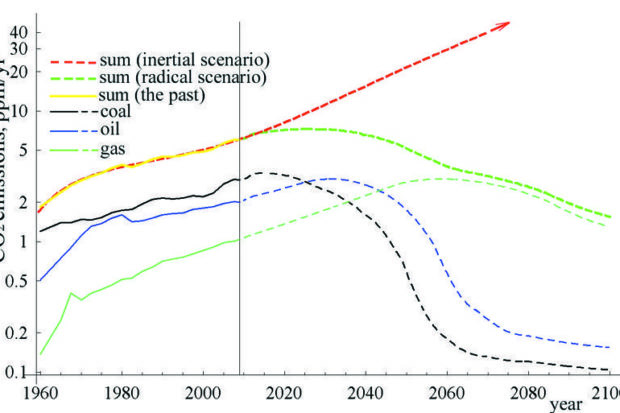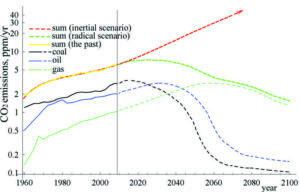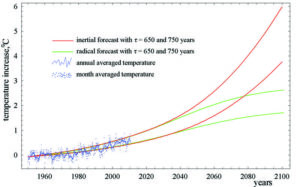
By Alexey V. Byalko and George B. Kauffman
(Click here to read Part 1, published in the September 2012 Community Alliance.)
The Future Climate
The greenhouse effect was first proposed in the 19th century by prominent physicists, on the basis of considerable scientific evidence. In this process, thermal radiation from a planetary surface is absorbed by atmospheric greenhouse gases and is re-radiated in all directions. Because part of this re-radiation is back toward the surface and lower atmosphere of the planet, it results in an elevation of the average surface temperature above what it would be in the absence of the gases. Although the effect is disputed by some partisan, nonprofessional persons, it is a scientifically proven fact. Figures 2(a), (b) and (c) compare the theoretical prognoses with the actual data for the greenhouse effect.
Three gases—carbon dioxide (CO2), water vapor (H2O) and methane (CH4)—result in the increased heating of the lower troposphere compared to the upper levels of the Earth’s atmosphere. The atmospheric CO2 concentration has increased significantly since the pre-industrial era—from 280 ppm to 390 ppm. The cause is the burning of fossil fuels (coal, oil and natural gas). From the rate of use of these fuels, which is well known, we can calculate the total amount of CO2 emitted to the atmosphere, which is about one-half of the present concentration, the remainder being absorbed by ocean water, primarily in the polar regions. By using the existent delay between the carbon fuel burning and actual gas content in the atmosphere (26.3 ± 1.2 years), we can predict future CO2 emissions, depending on the future burning of fossil fuels (Figure 2(a)).
A balanced curve exists between CO2 concentrations and global average surface temperatures under stable conditions. The following line approximation of this curve (Figure 2(b)) was obtained from data on Antarctic ice drilling (Byalko, 2012).
The potential annual increase in CO2 concentration is the total result of coal, oil and natural gas combustion. The inertial scenario supposes the same result of fossil fuel combustion. The radical scenario is based on rapid coal prohibition and then oil consumption for the production of chemical substances such as plastics.

The present temperature values don’t correspond to modern CO2 concentrations because the ocean surface, which determines temperature, simply “doesn’t know” that humans have pumped so much greenhouse gases into the atmosphere; the ocean needs some time to relax to the new concentrations. This relaxation time has been estimated to be about 700 years, which is considerably greater than the 130 years that have elapsed since the industrial era began. Results from simple equations of relaxation theory of climate are close to the predictions by world climate centers, which use complicated computer programs to evaluate the influence of greenhouse gases.
The near future CO2 concentrations and temperature changes depend strongly on our current economic development. The situation is critical. If the world proceeds as before the middle of the current century, our climate will undergo absolutely inappropriate conditions, possibly even irreversible ones. In the radical scenario, the maximum CO2 emission occurs in 2030, but its maximum concentration is attained only in 2042, and the temperature reaches some limit (possibly, a maximum) only by the end of the 21st century (Figure 2(c)). This warming leads to one more unpleasant consequence, that is, climate perturbations increase proportionally to the time derivative of temperature (Byalko, Vaganova & Rumanov, 2010). Therefore, we can conclude that in the radical scenario weather anomalies will become maximal by the mid–21st century, when the CO2 concentration exceeds its maximum.
What must we do?
Political discussions about what some countries should or shouldn’t do have proven to be unproductive. We must take strong measures independently of country, mood and national priority. Among fossil fuels, coal is the most dangerous. Each terawatt—one trillion (109) watts—of energy produced by burning coal emits 0.74 ppm of CO2 per year to the atmosphere, whereas oil and natural gas emit 0.39 ppm and 0.3 ppm, respectively, per year.

Therefore, we must prohibit coal mining. Well, not immediately. A transition period, for example, 10–15 years, could be allowed to resolve the resulting social issues. This is not a complete program for CO2 reduction, but a first step is necessary now. Natural gas could replace coal and oil in the first stages of a CO2 reduction program. We can’t estimate the economic expenses involved in prohibiting coal. They will undoubtedly be huge, but they are necessary and inevitable.
We are now in the midst of a crisis. However, it isn’t a “normal” crisis that’ll be followed by a general
recovery. Perhaps it actually means the end of progress in its simple sense, where the gross domestic product (GDP) grows several percent per year. However, keep in mind that changes in population growth and the drive toward climate stabilization may possibly lead to some shifts in our current moral and ethical doctrines.
Information Progress
So as not to conclude on such a pessimistic note, let’s add some comments about scientific and technical progress. The dependence on time of the accumulated sum of knowledge is not difficult to calculate for the present and to estimate for the past. However, information also has some aspects such as the possibility of obtaining it, the speed of exchange, reliability, etc., so we’ll avoid dealing with it quantitatively or in terms of time.
At any rate, it is evident that total world knowledge has increased in the past even more rapidly than the human population, and we can’t detect any limits to its growth. Yet can it possibly decrease under conditions of economic crisis? Historically, the greatest losses to culture and scientific achievement have
occurred during wars.

Perhaps the most egregious example was the destruction of the Bibliotheca Alexandrina, the largest and most significant library of the ancient world, on four occasions (48 BCE, 270–275 BCE, 391 BCE and 642 CE). Can an analogous event occur in the future? Could a powerful computer virus destroy our electronic libraries? The possibility for this would seem to be low, for electronic information is currently copied in sufficiently large numbers so that the most valuable data are carefully saved.
Another danger to the preservation of information that we have already experienced is the degradation of accumulated knowledge under exponentially growing false issues, disinformation or simply “facts” not vetted by knowledgeable professionals. We have already seen how lower levels of education during conditions of economic difficulties have led to a resurgence of anti-intellectualism, chemophobia and anti-scientific attitudes.
Despite this plethora of ills, let’s join with Alexander Pope: “Hope springs eternal in the human breast.”
To return to our initial question, can we predict the future? Yes, but our present prognoses are limited in time both mathematically and physically. The more distant future depends on the political and economic decisions that we make now. So, let’s begin without delay!
References
Byalko, A.V. (2012). Relaxation theory of climate. Physics Uspekhi, 55(1), 103–108.
Byalko, A.V., Vaganova, N.I., & Rumanov, E.N. (2010). On possible climatic instability. Doklady Physics, 55(4), 168–171.
*****
 Alexey V. Byalko, Ph.D. in astrophysics and cosmology; associate fellow, Landau Institute for Theoretical Physics, Russian Academy of Sciences, Chernogolovka, Moscow Region; deputy editor-in-chief of the journal Priroda (Nature) of the Presidium of the RAS since 1993; and author of the book, Nuclear Waste Disposal: Geophysical Safety, and more than 200 articles.
Alexey V. Byalko, Ph.D. in astrophysics and cosmology; associate fellow, Landau Institute for Theoretical Physics, Russian Academy of Sciences, Chernogolovka, Moscow Region; deputy editor-in-chief of the journal Priroda (Nature) of the Presidium of the RAS since 1993; and author of the book, Nuclear Waste Disposal: Geophysical Safety, and more than 200 articles.

George B. Kauffman, Ph.D., chemistry professor emeritus at California State University, Fresno, and Guggenheim Fellow, is a recipient of the American Chemical Society’s George C. Pimentel Award in Chemical Education, the Helen M. Free Award for Public Outreach and the Award for Research at an Undergraduate Institution, as well as numerous domestic and international honors. In 2011, he was appointed an ACS fellow.
